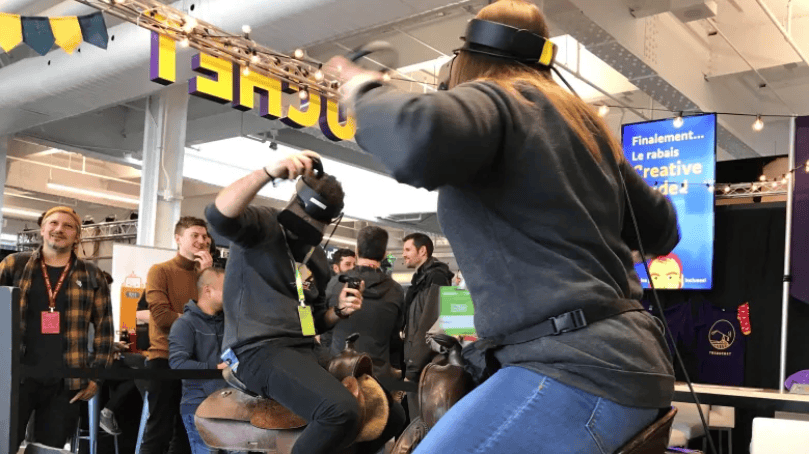
Conditions vary from ‘great’ to ‘absolute garbage,’ veteran developer says
Standing before a crowd of keen industry professionals earlier this week, Jayson Hilchie, the president of the Entertainment Software Association of Canada, painted a bright picture of the video game industry in this country.
Some 692 game companies pumped more than $4.5 billion into the Canadian economy in 2019 — all while paying their 48,000 employees almost double the country’s average salary, Hilchie told the Montreal International Game Summit (MIGS), offering new 2019 statistics for the first time.
The audience applauded.
After the presentation, a worker in the crowd raised his hand.
He asked Hilchie if that meant working conditions for developers would improve.
It’s a question that has plagued the fast-growing video game industry, as stories of mandatory overtime, abusive practices and burn out ripple through Montreal’s studios.
A ‘garbage dump’ of issues
Henrik Jonsson said he witnessed a host of problems during his 22 years as a video game developer.
Now an investor, Jonsson spoke at MIGS about how to “survive” in the video game industry, but said he doesn’t blame or judge anyone who chooses to leave.
Jonsson went through what he called a “garbage dump” of issues that most developers have to deal with, including “crunch” — when teams rush to complete a game in time for its scheduled release.
Some developers have described crunch as 16-hour days, seven days a week, sometimes for months at a time. It’s a long-standing feature of the video game industry that is often presented as mandatory, sometimes without overtime pay.
“Some studios are great, don’t crunch, have good healthy language norms, they have a good way that people talk to each other,” Jonsson said in an interview after his presentation.
“Others are absolute garbage.”

A 2017 survey by the International Game Developers Association found 53 per cent of employees said crunch was expected at their workplace. Of those, 37 per cent said they never received compensation for the overtime.
Those that did said they received free meals (37 per cent) and future time off (32 per cent) in exchange for crunch. Only 18 per cent received overtime pay.
“There’s a problem with companies that don’t view crunch as wrong,” Jonsson said.
He also pointed to problems with workplace culture and sexual harassment in a predominantly male industry, describing one studio he worked in as a “frat house,” a setting, he said, that can be alienating at best and abusive at worst.
But not all problems are internal. Jonsson highlighted the stress that comes from online comments, when dissatisfied consumers target individual developers with hate and abuse over social media.
Altogether, it leads to an environment that some find untenable. Jonsson said the average career in video games lasts only four years — and for women and people of colour, it’s even shorter.
“It’s a large industry, there’s a lot of young developers coming in, but they leave relatively quickly,” he said.
“Overworked, or underappreciated, or underpaid … it’s rarely just one factor.”
Changing the game
When asked about conditions in the industry, Hilchie said it’s in companies’ best interests to keep employees as “creative and free” as possible.
“Over the years, problems that may have existed are being fixed and looked at internally,” he said, “and I think the industry is making good strides in that.”
But that isn’t what activists in the industry are hearing.
Carolyn Jong is an organizer with Game Workers Unite Montreal, a group advocating for workers’ rights in the video game industry, with chapters around the world.
“A lot of cases, people are feeling like their employer keeps demanding more and more and more of them, to the point where it ends up affecting their health,” she said.
“People end up with serious conditions after the fact where they can’t do anything, can’t get out of bed. They feel disconnected from their family, disconnected from their friends, they have no personal life. And folks feel disposable.”

Jong held an event at MIGS to teach game workers about their rights in the workplace.
She said that because the workforce in video games skews so young — the average age in Canada is 31 years old — many workers don’t know how to push back against abusive practices.
One solution Jong’s organization proposes is unionization. According to her, none of the video game studios in the province has a union.
When asked about the possibility, Hilchie said he didn’t think it would be best for the industry.
“Anytime you start looking at collectives with respect to unionization, there’s a risk you’re going to lose that [creativity],” he said.
Jong disagreed, describing that reasoning as “a common union-busting tactic” that game workers repeatedly hear in the industry.
If anything, she said unionization would make games better.
“Because you have folks … who can feel they can stay [in the industry], and focus on their work in a way you can’t when you’re working 80-hour weeks,” she said.
It’s a message that seems to be resonating.
A push to ‘know your rights’
Presentations at MIGS normally focus on technical subjects in the industry, such as tips for accurately emulating the laws of physics in-game or what makes a good character design.
This year, four separate presentations — including those by Jong and Jonsson — at the two-day summit were about work environments and conditions in the industry.

After her presentation, a small crowd formed around Jong, asking follow-up questions as she handed out booklets, the words “Know Your Rights” printed in bright red on the cover.
She said she doesn’t know how long it will take for a studio’s workforce to unionize, but is hopeful that it’s not too far off.
“It takes a long time, even if conditions are bad,” she said, because the video game workforce has so little experience with workers’ rights movements.
“But we need to get people to think about what working together collectively can actually accomplish for them.”


